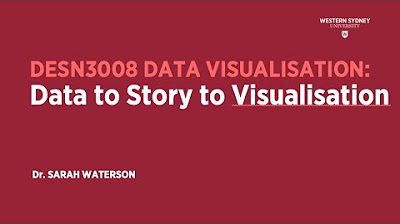Telling a Story with Data | Dashboard Build Demo
Summary
TLDRThis video delves into the importance of data storytelling and dashboard design, focusing on how data visualization can be effectively used for decision-making. It covers a six-step framework to craft clear, impactful dashboards, starting with defining the purpose and selecting the right metrics. It emphasizes eliminating clutter, using layout to focus attention, and telling a coherent story with data. Through an example of designing a dashboard for Maven Toys, the video demonstrates the process from start to finish, offering valuable insights on how to communicate data effectively in business contexts.
Takeaways
- 😀 Data literacy is essential for everyone, not just tech professionals or analysts, as everyone works with data to some degree.
- 😀 Data storytelling and dashboard design are crucial for effectively communicating data insights, especially in the context of business decision-making.
- 😀 A six-step framework for data storytelling and dashboard design includes defining the purpose, choosing the right metrics, presenting data effectively, eliminating clutter, focusing attention with layout, and telling a clear story.
- 😀 Defining the purpose of a dashboard involves understanding the audience, business goals, key questions, and review frequency.
- 😀 Choosing the right metrics requires aligning data with business goals and ensuring the level of detail is suitable for the audience's needs.
- 😀 Effective data presentation requires selecting the right types of visuals, such as line charts for revenue trends and KPI cards for high-level performance.
- 😀 Eliminating clutter and noise from dashboards improves clarity and usability, such as removing unnecessary gridlines, simplifying axis labels, and using color strategically.
- 😀 Layout plays a significant role in guiding viewers' attention to the most important data points, using principles like proximity, size, and color to enhance readability.
- 😀 It is important to start with high-level data and progressively show more granular details, following common reading patterns like Z or F patterns to ensure a logical flow.
- 😀 Clear storytelling through dashboards can be achieved by replacing default chart titles with descriptive text and highlighting key insights with visual emphasis.
- 😀 Final insights and recommendations, such as product offerings or restocking strategies, should tie the story together and provide actionable takeaways for decision-makers.
Q & A
What is data literacy, and why is it important for everyone to have these skills?
-Data literacy is the ability to understand and work with data. It is important for everyone because, in today's world, almost all industries and roles use data in some form. Whether you're working in tech, healthcare, finance, or retail, data literacy helps you make informed decisions, improve efficiency, and drive success.
What is the main difference between data visualization and data storytelling?
-Data visualization focuses on presenting data through charts and visuals. Data storytelling, on the other hand, takes that data and visualizes it in a way that conveys a narrative, helping the audience understand the context and significance behind the numbers.
Why is dashboard design crucial for effective data storytelling?
-Dashboard design is crucial because it consolidates data in a user-friendly way, facilitating decision-making. A well-designed dashboard highlights key insights, removes unnecessary clutter, and guides the user to make data-driven decisions efficiently.
What are the six steps in the data storytelling and dashboard design framework?
-The six steps are: 1) Define the purpose, 2) Choose the right metrics, 3) Present the data effectively, 4) Eliminate clutter and noise, 5) Use layout to focus attention, and 6) Tell a clear story.
How do you define the purpose of a dashboard in the context of data storytelling?
-Defining the purpose involves understanding who the audience is, what their goals are, what questions they need answered, and how frequently the dashboard will be reviewed. This ensures that the dashboard is aligned with user needs and business objectives.
What role do metrics play in the dashboard design process?
-Metrics help ensure that the data presented aligns with business goals and provides actionable insights. Choosing the right metrics is key to ensuring the dashboard is useful and relevant to the audience, providing a clear view of performance and progress.
What are some of the best practices for presenting data effectively in dashboards?
-Best practices include using the appropriate chart types (e.g., line charts for trends, bar charts for comparisons), simplifying the data to avoid overwhelming the user, and ensuring that the visuals are clear, intuitive, and easy to interpret.
How can you eliminate clutter and noise in dashboard design?
-To eliminate clutter, remove unnecessary grid lines, background images, excessive colors, and 3D effects. Focus on essential elements and streamline visuals to make them cleaner and more focused on key insights.
What is the significance of layout in dashboard design?
-Layout is important because it guides the user's attention in a logical flow. Using design principles like proximity, size, and color helps highlight the most important information and ensures the viewer follows a coherent narrative across the dashboard.
How can data storytelling enhance the effectiveness of dashboards?
-Data storytelling enhances dashboards by providing context to the data. By using descriptive titles, text annotations, and a narrative structure, the viewer can easily understand the story behind the data, making the insights more impactful and easier to act on.
Outlines

This section is available to paid users only. Please upgrade to access this part.
Upgrade NowMindmap

This section is available to paid users only. Please upgrade to access this part.
Upgrade NowKeywords

This section is available to paid users only. Please upgrade to access this part.
Upgrade NowHighlights

This section is available to paid users only. Please upgrade to access this part.
Upgrade NowTranscripts

This section is available to paid users only. Please upgrade to access this part.
Upgrade NowBrowse More Related Video
5.0 / 5 (0 votes)





